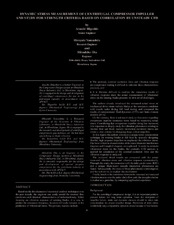| dc.description.abstract | Based on the development of numerical analysis techniques over the past decade, the engineer can easily model the internal flow conditions and vibration characteristics of turbomachinery. When focusing on vibration response of rotating blades, it is easy to predict the resonance frequency; however difficulty remains in the prediction of vibrational stress. The primary reasons include: The unsteady external excitation force and vibration response are complicated making it difficult to calculate these characteristics precisely, and; It is likewise difficult to confirm the simulation results of vibration response since the actual measurement of vibrational stress on the rotating blades presents its own set of challenges. The authors already introduced the measured actual stress on mechanical drive steam turbine blades at the resonance condition with nozzle wake during full load testing and compared the results of computational fluid dynamics (CFD) and finite element analysis (FEA). On the contrary, there is not much study or discussion regarding compressor impeller resonance stress based on measuring actual stress. Considering that compressor impeller sizing has increased, it is important to deeply study the vibration phenomena relating to internal flow and blade cascade interaction excitation forces and create a clear criteria for designing large, robust impellers. In this regard, the authors introduce a unique stress measurement technique for rotating blades at full load by specially designing flexible, high response impellers to emphasize the vibration stress. The basic vibration characteristics of the nodal diameter interference diagram and Campbell diagram are explained. In order to estimate vibrational stress on the blades, the unsteady CFD analysis is applied for calculation of the external excitation force and the vibration response is analyzed. The analyzed detail results are compared with the actual measured vibration stress and vibration response systematically. Through this study, the resonance with the inlet guide vanes (IGV) and a unique blade/stator cascade interaction phenomena are found. Subsequently, the cause of these phenomena is investigated, and the authors try to explain this mechanism. Finally, based on the correlation between the measured and analyzed vibration stresses over the entire whole flow path, the strength criterion is studied as a guideline, by comparing application experience. | en |


